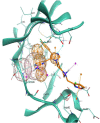Implementing a Scoring Function Based on Interaction Fingerprint for Autogrow4: Protein Kinase CK1δ as a Case Study
- PMID: 35874609
- PMCID: PMC9301033
- DOI: 10.3389/fmolb.2022.909499
Implementing a Scoring Function Based on Interaction Fingerprint for Autogrow4: Protein Kinase CK1δ as a Case Study
Abstract
In the last 20 years, fragment-based drug discovery (FBDD) has become a popular and consolidated approach within the drug discovery pipeline, due to its ability to bring several drug candidates to clinical trials, some of them even being approved and introduced to the market. A class of targets that have proven to be particularly suitable for this method is represented by kinases, as demonstrated by the approval of BRAF inhibitor vemurafenib. Within this wide and diverse set of proteins, protein kinase CK1δ is a particularly interesting target for the treatment of several widespread neurodegenerative diseases, such as Alzheimer's disease, Parkinson's disease, and amyotrophic lateral sclerosis. Computational methodologies, such as molecular docking, are already routinely and successfully applied in FBDD campaigns alongside experimental techniques, both in the hit-discovery and in the hit-optimization stage. Concerning this, the open-source software Autogrow, developed by the Durrant lab, is a semi-automated computational protocol that exploits a combination between a genetic algorithm and a molecular docking software for de novo drug design and lead optimization. In the current work, we present and discuss a modified version of the Autogrow code that implements a custom scoring function based on the similarity between the interaction fingerprint of investigated compounds and a crystal reference. To validate its performance, we performed both a de novo and a lead-optimization run (as described in the original publication), evaluating the ability of our fingerprint-based protocol to generate compounds similar to known CK1δ inhibitors based on both the predicted binding mode and the electrostatic and shape similarity in comparison with the standard Autogrow protocol.
Keywords: Autogrow; de novo drug design; fragment growing; fragment-based drug discovery; interaction fingerprint; lead optimization; neurodegenerative diseases; protein kinase CK1δ.
Copyright © 2022 Pavan, Menin, Bassani, Sturlese and Moro.
Conflict of interest statement
The authors declare that the research was conducted in the absence of any commercial or financial relationships that could be construed as a potential conflict of interest.
Figures
















Similar articles
-
A Computational Workflow for the Identification of Novel Fragments Acting as Inhibitors of the Activity of Protein Kinase CK1δ.Int J Mol Sci. 2021 Sep 9;22(18):9741. doi: 10.3390/ijms22189741. Int J Mol Sci. 2021. PMID: 34575906 Free PMC article.
-
AutoGrow4: an open-source genetic algorithm for de novo drug design and lead optimization.J Cheminform. 2020 Apr 17;12(1):25. doi: 10.1186/s13321-020-00429-4. J Cheminform. 2020. PMID: 33431021 Free PMC article.
-
Evaluating AutoGrow4 - an open-source toolkit for semi-automated computer-aided drug discovery.Expert Opin Drug Discov. 2025 Jun;20(6):711-720. doi: 10.1080/17460441.2025.2499122. Epub 2025 May 2. Expert Opin Drug Discov. 2025. PMID: 40299468 Review.
-
AutoGrow 3.0: an improved algorithm for chemically tractable, semi-automated protein inhibitor design.J Mol Graph Model. 2013 Jul;44:104-12. doi: 10.1016/j.jmgm.2013.05.006. Epub 2013 May 23. J Mol Graph Model. 2013. PMID: 23792207 Free PMC article.
-
Fragment informatics and computational fragment-based drug design: an overview and update.Med Res Rev. 2013 May;33(3):554-98. doi: 10.1002/med.21255. Epub 2012 Mar 19. Med Res Rev. 2013. PMID: 22430881 Review.
Cited by
-
A comprehensive study of SARS-CoV-2 main protease (Mpro) inhibitor-resistant mutants selected in a VSV-based system.bioRxiv [Preprint]. 2023 Oct 4:2023.09.22.558628. doi: 10.1101/2023.09.22.558628. bioRxiv. 2023. Update in: PLoS Pathog. 2024 Sep 11;20(9):e1012522. doi: 10.1371/journal.ppat.1012522. PMID: 37808638 Free PMC article. Updated. Preprint.
-
Post-Docking Refinement of Peptide or Protein-RNA Complexes Using Thermal Titration Molecular Dynamics (TTMD): A Stability Insight.J Chem Inf Model. 2025 Feb 10;65(3):1441-1452. doi: 10.1021/acs.jcim.4c01393. Epub 2025 Jan 16. J Chem Inf Model. 2025. PMID: 39818831 Free PMC article.
-
Structural Investigations on 2-Amidobenzimidazole Derivatives as New Inhibitors of Protein Kinase CK1 Delta.Pharmaceuticals (Basel). 2024 Apr 7;17(4):468. doi: 10.3390/ph17040468. Pharmaceuticals (Basel). 2024. PMID: 38675428 Free PMC article.
-
Federated Learning in Computational Toxicology: An Industrial Perspective on the Effiris Hackathon.Chem Res Toxicol. 2023 Sep 18;36(9):1503-1517. doi: 10.1021/acs.chemrestox.3c00137. Epub 2023 Aug 16. Chem Res Toxicol. 2023. PMID: 37584277 Free PMC article.
-
Qualitative Estimation of Protein-Ligand Complex Stability through Thermal Titration Molecular Dynamics Simulations.J Chem Inf Model. 2022 Nov 28;62(22):5715-5728. doi: 10.1021/acs.jcim.2c00995. Epub 2022 Oct 31. J Chem Inf Model. 2022. PMID: 36315402 Free PMC article.
References
-
- AutoGrow4 (2020). AutoGrow4 – Durrant Lab. Available at: https://durrantlab.pitt.edu/autogrow4/ .
LinkOut - more resources
Full Text Sources
Research Materials
Miscellaneous

